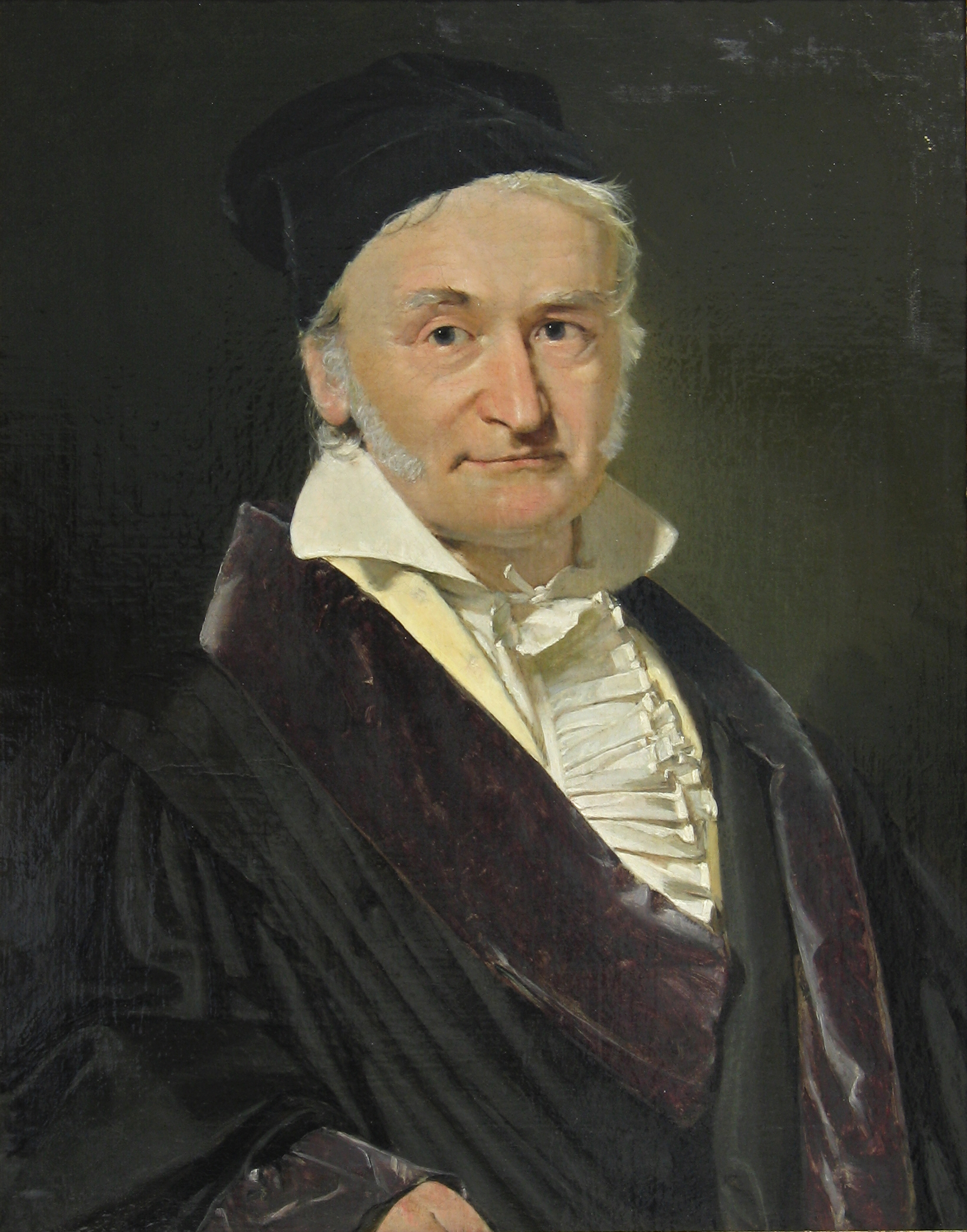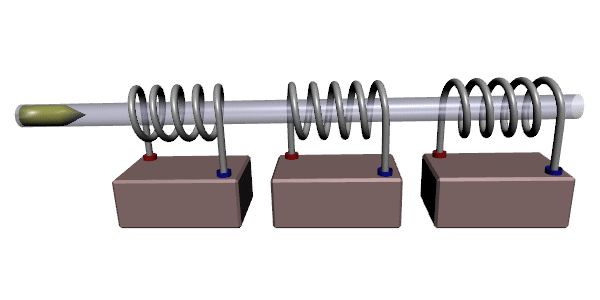Gaussian on:
[Wikipedia]
[Google]
[Amazon]



Encyclopedia of Mathematics
* Gauss's hypergeometric theorem, an identity on hypergeometric series * Gauss plane
 *
*
website of University of Toronto
* Gauss linking integral (
WolframMathWorld
*Gaussian's
 *
*


Carl Friedrich Gauss
Johann Carl Friedrich Gauss (; german: Gauß ; la, Carolus Fridericus Gauss; 30 April 177723 February 1855) was a German mathematician and physicist who made significant contributions to many fields in mathematics and science. Sometimes refer ...
(1777–1855) is the eponym of all of the topics listed below.
There are over 100 topics all named after this German mathematician and scientist, all in the fields of mathematics, physics, and astronomy. The English eponymous adjective ''Gaussian'' is pronounced .
Mathematics
Algebra
Algebra () is one of the broad areas of mathematics. Roughly speaking, algebra is the study of mathematical symbols and the rules for manipulating these symbols in formulas; it is a unifying thread of almost all of mathematics.
Elementary a ...
and linear algebra
Linear algebra is the branch of mathematics concerning linear equations such as:
:a_1x_1+\cdots +a_nx_n=b,
linear maps such as:
:(x_1, \ldots, x_n) \mapsto a_1x_1+\cdots +a_nx_n,
and their representations in vector spaces and through matrices.
...
Geometry
Geometry (; ) is, with arithmetic, one of the oldest branches of mathematics. It is concerned with properties of space such as the distance, shape, size, and relative position of figures. A mathematician who works in the field of geometry is ...
and differential geometry
Differential geometry is a mathematical discipline that studies the geometry of smooth shapes and smooth spaces, otherwise known as smooth manifolds. It uses the techniques of differential calculus, integral calculus, linear algebra and multilin ...
Number theory
Number theory (or arithmetic or higher arithmetic in older usage) is a branch of pure mathematics devoted primarily to the study of the integers and integer-valued functions. German mathematician Carl Friedrich Gauss (1777–1855) said, "Mathe ...
Cyclotomic field
In number theory, a cyclotomic field is a number field obtained by adjoining a complex root of unity to , the field of rational numbers.
Cyclotomic fields played a crucial role in the development of modern algebra and number theory because of th ...
s
*Gaussian period
In mathematics, in the area of number theory, a Gaussian period is a certain kind of sum of roots of unity. The periods permit explicit calculations in cyclotomic fields connected with Galois theory and with harmonic analysis (discrete Fourier tra ...
*Gaussian rational
In mathematics, a Gaussian rational number is a complex number of the form ''p'' + ''qi'', where ''p'' and ''q'' are both rational numbers.
The set of all Gaussian rationals forms the Gaussian rational field, denoted Q(''i''), obtained ...
*Gauss sum
In algebraic number theory, a Gauss sum or Gaussian sum is a particular kind of finite sum of roots of unity, typically
:G(\chi) := G(\chi, \psi)= \sum \chi(r)\cdot \psi(r)
where the sum is over elements of some finite commutative ring , is ...
, an exponential sum
In mathematics, an exponential sum may be a finite Fourier series (i.e. a trigonometric polynomial), or other finite sum formed using the exponential function, usually expressed by means of the function
:e(x) = \exp(2\pi ix).\,
Therefore, a typic ...
over Dirichlet character
In analytic number theory and related branches of mathematics, a complex-valued arithmetic function \chi:\mathbb\rightarrow\mathbb is a Dirichlet character of modulus m (where m is a positive integer) if for all integers a and b:
:1) \ch ...
s
** Elliptic Gauss sum, an analog of a Gauss sum
In algebraic number theory, a Gauss sum or Gaussian sum is a particular kind of finite sum of roots of unity, typically
:G(\chi) := G(\chi, \psi)= \sum \chi(r)\cdot \psi(r)
where the sum is over elements of some finite commutative ring , is ...
**Quadratic Gauss sum In number theory, quadratic Gauss sums are certain finite sums of roots of unity. A quadratic Gauss sum can be interpreted as a linear combination of the values of the complex exponential function with coefficients given by a quadratic character; fo ...
Analysis
Analysis ( : analyses) is the process of breaking a complex topic or substance into smaller parts in order to gain a better understanding of it. The technique has been applied in the study of mathematics and logic since before Aristotle (3 ...
, numerical analysis
Numerical analysis is the study of algorithms that use numerical approximation (as opposed to symbolic manipulations) for the problems of mathematical analysis (as distinguished from discrete mathematics). It is the study of numerical methods t ...
, vector calculus
Vector calculus, or vector analysis, is concerned with differentiation and integration of vector fields, primarily in 3-dimensional Euclidean space \mathbb^3. The term "vector calculus" is sometimes used as a synonym for the broader subject ...
and calculus of variations
The calculus of variations (or Variational Calculus) is a field of mathematical analysis that uses variations, which are small changes in functions
and functionals, to find maxima and minima of functionals: mappings from a set of functions t ...
Complex analysis and
convex analysis
Convex analysis is the branch of mathematics devoted to the study of properties of convex functions and convex sets, often with applications in convex minimization, a subdomain of optimization theory.
Convex sets
A subset C \subseteq X of so ...
*Gauss–Lucas theorem
In complex analysis, a branch of mathematics, the Gauss–Lucas theorem gives a geometric relation between the roots of a polynomial ''P'' and the roots of its derivative ''P′''. The set of roots of a real or complex polynomial is a set of poin ...
*Gauss's continued fraction In complex analysis, Gauss's continued fraction is a particular class of continued fractions derived from hypergeometric functions. It was one of the first analytic continued fractions known to mathematics, and it can be used to represent several ...
, an analytic continued fraction derived from the hypergeometric functions
* Gauss's criterion – described oEncyclopedia of Mathematics
* Gauss's hypergeometric theorem, an identity on hypergeometric series * Gauss plane
Statistics
Gauss–Kuzmin distribution
In mathematics, the Gauss–Kuzmin distribution is a discrete probability distribution that arises as the limit probability distribution of the coefficients in the continued fraction expansion of a random variable uniformly distributed in (0,&nb ...
, a discrete probability distribution
In probability theory and statistics, a probability distribution is the mathematical function that gives the probabilities of occurrence of different possible outcomes for an experiment. It is a mathematical description of a random phenomenon ...
* Gauss–Markov process
*Gauss–Markov theorem
In statistics, the Gauss–Markov theorem (or simply Gauss theorem for some authors) states that the ordinary least squares (OLS) estimator has the lowest sampling variance within the class of linear unbiased estimators, if the errors in th ...
*Gaussian copula
In probability theory and statistics, a copula is a multivariate cumulative distribution function for which the marginal probability distribution of each variable is uniform on the interval , 1 Copulas are used to describe/model the d ...
*Gaussian measure
In mathematics, Gaussian measure is a Borel measure on finite-dimensional Euclidean space R''n'', closely related to the normal distribution in statistics. There is also a generalization to infinite-dimensional spaces. Gaussian measures are named ...
** Gaussian correlation inequality
** Gaussian isoperimetric inequality
* Gauss's inequality
In probability theory, Gauss's inequality (or the Gauss inequality) gives an upper bound on the probability that a unimodal random variable lies more than any given distance from its mode.
Let ''X'' be a unimodal random variable with mode ''m'', ...
Gaussian function and topics named for it
Knot theory
* Gauss code – described owebsite of University of Toronto
* Gauss linking integral (
knot theory
In the mathematical field of topology, knot theory is the study of mathematical knots. While inspired by knots which appear in daily life, such as those in shoelaces and rope, a mathematical knot differs in that the ends are joined so it cannot ...
)
Other mathematical areas
* Gauss's algorithm fordetermination of the day of the week
The determination of the day of the week for any date may be performed with a variety of algorithms. In addition, perpetual calendars require no calculation by the user, and are essentially lookup tables.
A typical application is to calculate the ...
* Gauss's Easter algorithm
* Gaussian bracket – described oWolframMathWorld
*Gaussian's
modular arithmetic
In mathematics, modular arithmetic is a system of arithmetic for integers, where numbers "wrap around" when reaching a certain value, called the modulus. The modern approach to modular arithmetic was developed by Carl Friedrich Gauss in his bo ...
*Gaussian integer
In number theory, a Gaussian integer is a complex number whose real and imaginary parts are both integers. The Gaussian integers, with ordinary addition and multiplication of complex numbers, form an integral domain, usually written as \mathbf /ma ...
, usually written as
:*Gaussian prime
In number theory, a Gaussian integer is a complex number whose real and imaginary parts are both integers. The Gaussian integers, with ordinary addition and multiplication of complex numbers, form an integral domain, usually written as \mathbf / ...
* Gaussian logarithm
In mathematics, addition and subtraction logarithms or Gaussian logarithms can be utilized to find the logarithms of the sum and difference of a pair of values whose logarithms are known, without knowing the values themselves.
Their mathematical ...
s (also known as addition and subtraction logarithms)
Cartography
Cartography (; from grc, χάρτης , "papyrus, sheet of paper, map"; and , "write") is the study and practice of making and using maps. Combining science, aesthetics and technique, cartography builds on the premise that reality (or an im ...
*Gauss–Krüger coordinate system
The transverse Mercator map projection (TM, TMP) is an adaptation of the standard Mercator projection. The transverse version is widely used in national and international mapping systems around the world, including the Universal Transverse Merca ...
* Gaussian grid
Physics
*Gaussian optics
Gaussian optics is a technique in geometrical optics that describes the behaviour of light rays in optical systems by using the paraxial approximation, in which only rays which make small angles with the optical axis of the system are considered. ...
Classical mechanics
Classical mechanics is a physical theory describing the motion of macroscopic objects, from projectiles to parts of machinery, and astronomical objects, such as spacecraft, planets, stars, and galaxies. For objects governed by classical m ...
*Gauss's principle of least constraint
The principle of least constraint is one variational formulation of classical mechanics enunciated by Carl Friedrich Gauss in 1829, equivalent to all other formulations of analytical mechanics. Intuitively, it says that the acceleration of a co ...
*For orbit determination
Orbit determination is the estimation of orbits of objects such as moons, planets, and spacecraft. One major application is to allow tracking newly observed asteroids and verify that they have not been previously discovered. The basic methods wer ...
in orbital mechanics
Orbital mechanics or astrodynamics is the application of ballistics and celestial mechanics to the practical problems concerning the motion of rockets and other spacecraft. The motion of these objects is usually calculated from Newton's laws of ...
:
**Gauss's law for gravity
In physics, Gauss's law for gravity, also known as Gauss's flux theorem for gravity, is a law of physics that is equivalent to Newton's law of universal gravitation. It is named after Carl Friedrich Gauss. It states that the flux (surface integr ...
**Gaussian gravitational constant
The Gaussian gravitational constant (symbol ) is a parameter used in the orbital mechanics of the Solar System.
It relates the orbital period to the orbit's semi-major axis and the mass of the orbiting body in Solar masses.
The value of histori ...
** Gaussian year
Quantum mechanics
Quantum mechanics is a fundamental theory in physics that provides a description of the physical properties of nature at the scale of atoms and subatomic particles. It is the foundation of all quantum physics including quantum chemistry, qu ...
*Gaussian orbital In computational chemistry and molecular physics, Gaussian orbitals (also known as Gaussian type orbitals, GTOs or Gaussians) are functions used as atomic orbitals in the LCAO method for the representation of electron orbitals in molecules and nu ...
Electromagnetism
In physics, electromagnetism is an interaction that occurs between particles with electric charge. It is the second-strongest of the four fundamental interactions, after the strong force, and it is the dominant force in the interactions of ...
 *
*gauss
Johann Carl Friedrich Gauss (; german: Gauß ; la, Carolus Fridericus Gauss; 30 April 177723 February 1855) was a German mathematician and physicist who made significant contributions to many fields in mathematics and science. Sometimes refer ...
, the CGS unit for magnetic field
A magnetic field is a vector field that describes the magnetic influence on moving electric charges, electric currents, and magnetic materials. A moving charge in a magnetic field experiences a force perpendicular to its own velocity and to ...
*Degaussing
Degaussing is the process of decreasing or eliminating a remnant magnetic field. It is named after the gauss, a unit of magnetism, which in turn was named after Carl Friedrich Gauss. Due to magnetic hysteresis, it is generally not possible to redu ...
, to demagnetize an object
* Gauss rifle or coilgun
*Gauss's law for magnetism
In physics, Gauss's law for magnetism is one of the four Maxwell's equations that underlie classical electrodynamics. It states that the magnetic field has divergence equal to zero, in other words, that it is a solenoidal vector field. It is ...
*Gaussian surface
A Gaussian surface is a closed surface in three-dimensional space through which the flux of a vector field is calculated; usually the gravitational field, electric field, or magnetic field. It is an arbitrary closed surface (the boundary of a 3- ...
**Gauss's law
In physics and electromagnetism, Gauss's law, also known as Gauss's flux theorem, (or sometimes simply called Gauss's theorem) is a law relating the distribution of electric charge to the resulting electric field. In its integral form, it stat ...
, giving the relationship between flux
Flux describes any effect that appears to pass or travel (whether it actually moves or not) through a surface or substance. Flux is a concept in applied mathematics and vector calculus which has many applications to physics. For transport ph ...
through a closed surface and the enclosed source
Awards and recognitions
*Carl Friedrich Gauss Prize The Carl Friedrich Gauss Prize for Applications of Mathematics is a mathematics award, granted jointly by the International Mathematical Union and the German Mathematical Society for "outstanding mathematical contributions that have found significa ...
, a mathematics award
* Gauss Lectureship, a mathematical distinction
* The Gauss Mathematics Competition in Canadian junior high schools, an annual national mathematics competition administered by the Centre for Education in Mathematics and Computing
The Centre for Education in Mathematics and Computing (CEMC) is a Canadian educational organization dedicated to promoting and creating activities and materials in mathematics and computer science. Founded in 1995 with origins dating back to the 1 ...
Place names and expedition named in his honour
Institutions named in his honour
* The Carl-Friedrich-Gauss School for Mathematics, Computer Science, Business Administration, Economics, and Social Sciences ofBraunschweig University of Technology
Braunschweig () or Brunswick ( , from Low German ''Brunswiek'' , Braunschweig dialect: ''Bronswiek'') is a city in Lower Saxony, Germany, north of the Harz Mountains at the farthest navigable point of the river Oker, which connects it to the N ...
* The Carl-Friedrich-Gauss Gymnasium (a school for grades 5–13) in Worms, Germany
Worms () is a city in Rhineland-Palatinate, Germany, situated on the Upper Rhine about south-southwest of Frankfurt am Main. It had about 82,000 inhabitants .
A pre-Roman foundation, Worms is one of the oldest cities in northern Europe. It ...
Other things named for him
160px, Gaussia maya * '' Gaussia'', a palm genus described by Hermann Wendland with the then new species '' Gaussia princeps'', collected by Charles Wright in western Cuba. Named in “memoriam astronomi Caroli Friderici Gauss”.Wendland, H., 1865. Ueber die neue Palmengatung Gaussia. Nachr. Königl. Ges. Wiss. Georg-Augusts-Univ. 1865. * '' Gaussia'', a genus ofcopepod
Copepods (; meaning "oar-feet") are a group of small crustaceans found in nearly every freshwater and saltwater habitat. Some species are planktonic (inhabiting sea waters), some are benthic (living on the ocean floor), a number of species have p ...
s
*Gaussian
Carl Friedrich Gauss (1777–1855) is the eponym of all of the topics listed below.
There are over 100 topics all named after this German mathematician and scientist, all in the fields of mathematics, physics, and astronomy. The English eponymo ...
, a computational chemistry software program
*GAUSS
Johann Carl Friedrich Gauss (; german: Gauß ; la, Carolus Fridericus Gauss; 30 April 177723 February 1855) was a German mathematician and physicist who made significant contributions to many fields in mathematics and science. Sometimes refer ...
, a matrix programming language for mathematics and statistics
References
{{reflistGauss
Johann Carl Friedrich Gauss (; german: Gauß ; la, Carolus Fridericus Gauss; 30 April 177723 February 1855) was a German mathematician and physicist who made significant contributions to many fields in mathematics and science. Sometimes refer ...
List of things